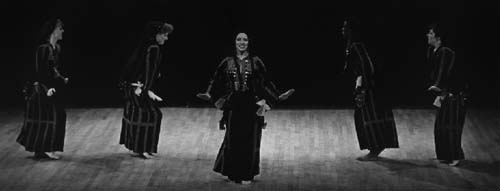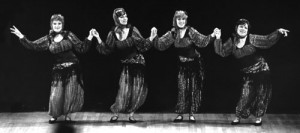
When done there “authentically”, it is performed by one heavily-veiled woman dancing before a line of clapping, chanting men (called “Keffafeen”), who do not dance at all, except for one man that the Haggala chooses from among them.
Hagallah was a Libyan girl’s coming-of-age dance, done by one young girl, whose face and head were covered. It celebrated her reaching puberty – telling her how beautiful she is becoming, what a wonderful wife and mother she’ll be, how lucky the man who marries her. It lauded the power and richness of the world of women and girls, their grace, beauty, individuality – so it is playful and joyous, but not flirtatious.
Her head is covered to protect her modesty and her and her family’s reputation in front of the men and, when in its real cultural context (not as entertainment by a professional at a wedding or celebration), this ceremonial dance is a turning point in her life, after which she’ll wear the burkha or face veil and be eligible to be married. It was never a dance for choosing one’s mate – the negotiations and processes required for that are way too long and complex to be decided at any sort of celebration – nor is it any sort of competition over a man, since neither of these were made into public spectacles.
Hagallah,has specific “steps”, but the sequence depends on the Hagallah herself. It can be done authentically, but how theater “folk” companies in Egypt do it is not – they take a great deal of artistic license. In Egypt this dance was found most often in Mersa Matruh.
The word hagallah refers to the dance, the female doing it and the accompaniment – the same sort of blanket name as with Guedra (to which it bears no other resemblance in any way). There are at least two stories about the root of the word:
1) From the word hag’l, meaning to skip or hop or
2) the hagal is a bird indigenous to the Sinai, with a funny, sort of “hoppy” walk because the sand is hot – which is why they call that bird a hagal …
This walk is supposedly imitated by dancers, who do short triple hip accents (up-down-sit) at every small step – pretty much the only “step”, with slight variations and direction changes, depending on which group of kefafim she feels is being more enthusiastic and inviting, continuing until she is tired or the kefafim’s enthusiasm slacks off. After a bit, it starts again.
Casbah´s version shows a group of women dancing just for themselves.

